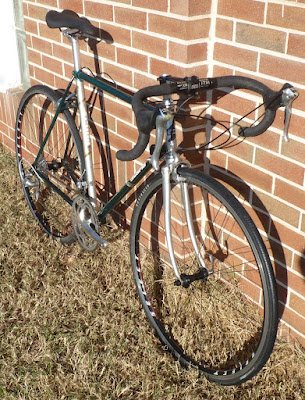The first frameset came to me indirectly from my friend Walt, who had spied this unique Colnago Export frame on the Facebook page of an aquaintence of ours who sells bicycles and parts in the Netherlands. I have bought a few complete bikes and framesets from Arthur, and he always offers great products at a fair price, packages his items carefully and ships them in a very timely manner.
This was one of the few times I have ever experienced an error in one of his listings, and Walt was very disappointed to find the frame a bit too large for his liking. I was very willing to take the frame off of his hands, as the Export was essentially a Super, with the same design elements and geometry. The frames were marketed for affordability, as Colnago used a slightly heavier, mid-range tube set, instead of the high-end Columbus SL steel, and the complete bikes were sold with lower level Campagnolo groups.
This frame was manufactured with Columbus GT (Gran Turismo) tubing and includes many engravings (pantografia) similar to its more expensive brethren. The frame also has a very similar paintjob to the Super coming up later in this blog, but is a bit of a lighter green, and the pattern is a bit more complex, with a subtle spiral of color on the top tube.
I have a really nice set of Campagnolo 8-speed components for this frame, and though there are some compatible wheelsets hanging in the shop, they are of a bit higher quality. I'll probably want to keep this project more at the intended level of affordability and search for something more appropriate.
I came across another quality Italian frameset, in the form of Basso's top-of-the-line "Gap" model. I'm a bit of a sucker for the classic color band paint scheme, and this one has attractive design of white with royal blue decals. The tubing here is Columbus SL, and I will be assembling the bicycle with higher-end Campagnolo 8-speed gruppo, and an appropriate Cinelli or 3T cockpit.
I've built up a few Basso bicycles over the years, and I'm a bit surprised not to have done more. However, I think the secret is out to their quality, so I don't find them available very often, at an affordable price. I was lucky to get this as a package deal with another frame.
...and that would be this Gitane. For a long time I had been looking for a frameset by the legendary French brand, and the model Trophee de France 1848 commemorates the date of the country's revolution. Translated as "gypsy woman", Gitane bicycles were ridden by greats like Jacques Anquetil, Bernard Hinault, Greg Lemond and Laurent Fignon - a collective fifteen Tour de France victories between them!
I was initially considering the assembly of this Reynolds 531 frame as a retro-modern machine, but I found an old 1978 company catalog and would now like to do an as-original project with Campagnolo Nuovo Record parts.
The Christmasy coloring of the Colnago Super I've had hanging in my shop inspired me to finish the build before taking a holiday break. A Campagnolo Athena 8-speed group and appropriate Cinelli parts finish off this all-Italian build:
Merry Christmas and Happy New Year to all!





















































